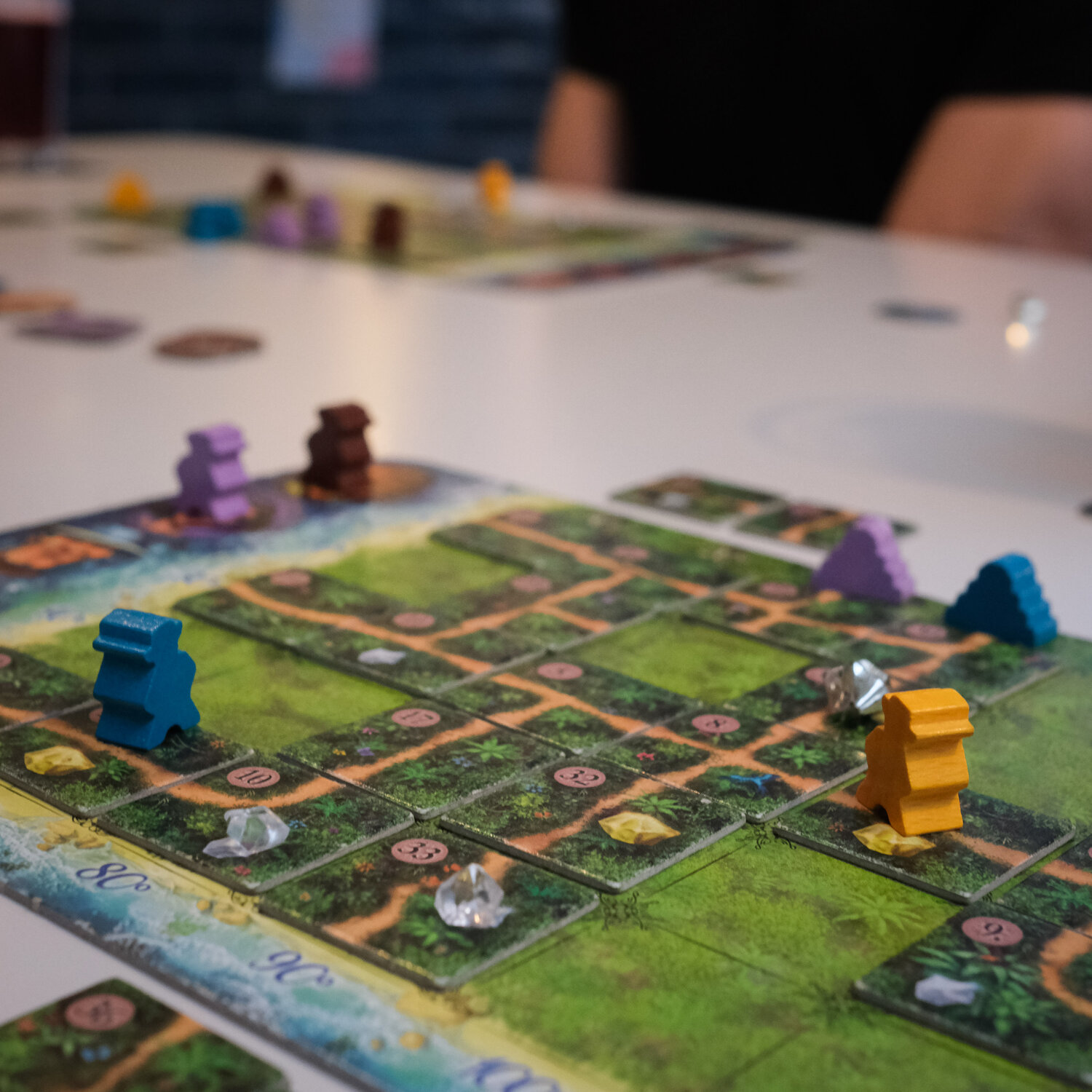Mythwind: Friends & Family
You’ll like this if you like: Stardew Valley, a hot cup of Coco with a blanket by the fire.
This is the reviewer’s copy after I backed both of the Kickstarter’s for the base game and this expansion; but the publisher sent me a play mat and Sprite miniatures upgrade for free. See our review policy here. I have played the game with all four available characters, but there is a fifth expansion character I don’t have. I have played in solo mostly, but also two-player.
If you want to read about how you play the base game and what we think of that, head here. The summary is, I love the game, and this love has only grown over time. I enjoy all the characters, although probably the Ranger the most. I have continued to enjoy unlocking and revealing new secrets and surprises as I have spent more and more time with this unique, relaxing, explorative, and never-ending game.
How To Set Up Mythwind: Friends & Family
OK, so what about this new expansion? The second for the game. Well, it adds a few modules that you can add to the game at your pleasure. But the star of the show is the new Friends and Family additional board. It sits to the right of the existing boards and can be added to any game at the end of any season. Slotted into anyone ongoing campaign, no worries at all.
You will find inside the box a few revised building tokens. They link to these new friends you are about to make. Swap all the tokens out from your original building cards, including any buildings you may have already built. Then, for these buildings, the ones you have already constructed within your Village, add in the corresponding friend card to the new friends board. When you do this, read the back of the card for some flavour text about this new friend you just met. Now place the new Friendship tray alongside this, with the Child Dice, Heart Tokens, and all the new cards inside. There are a few other cards to update, such as a replacement Sun card for the Weather deck, which has some additional symbols on it. And the new Interaction cards and some character-specific cards if you are currently playing with the Ranger or Innkeeper.
How To Play Mythwind: Friends & Family
The main change is when you interact with one of the new building tokens that have a character depicted on them in your daytime action phase. When this action is done, you can then take the new Socialise action. Here, you can roll your Sprite and Villager dice to try and increase your level of friendship with the associated friend card. The card will show the roll you need to match or beat. This will be based on your player count and the current level of friendship you have with them. All Friends join the game as an Acquaintance. You can advance them all to Pal, Best Friend, and then Companion. All players joining in with this Socialise action can roll any of their hired workers to try and meet this requirement. If you do, place a Heart from the supply on the card. Each level of friendship will have a level of hearts required to advance that card to the next stage. If you fail, you simply do not add any hearts onto the card. All dice used this way are returned to their character afterwards, keeping the same number of pips shown on the die. They cannot be used for another action that day now. Any dice showing zero pips are rerolled at dusk as usual, and added back to the tower. When you meet a desired level of hearts, that card is immediately upgraded to the next level. Find the new card in the deck, replace the old one, and read the back of the new card. This will add some new flavour text.
This upgrade will also come at a cost. The cost will depend upon which character you are playing, and the level of upgrade. It is shown in the rule book, but each character will have to give up some of their resources to do this. You can hold off paying this cost if you don’t want to, or cannot afford it yet.
And the point of all this? Well, to get married, of course! Not all friends can get to this level, but they can all reach Companion status. It is shown on the front of each card what is possible for each new character. Companion is the top level and will be a unique ability to you and your village. When you use a town linked to a Companion, you can use this new ability.
When buildings linked to Friends leave your Village, so too do the Friends, losing any unspent Hearts if present. But when you reach Marriage level, the Friend stays with you for life. When your marriage-eligible Friend becomes a companion, the new companion card will tell you to shuffle an adventure card from this new Expansion linked to that character into the adventure deck. Then, when you resolve that adventure, you can marry this friend. You will have a choice when you do this; you do not have to. I won’t show the cards here or go into it too much, as that would be a spoiler. But it is down to you. You can even say no for now, and then maybe change your mind later. But if you say yes, there are benefits coming your way.
Any married friend will then have their card from the Friend board moved and placed face up near the player’s character board. They are now permanently linked with that player. Players can now use this companion using workers as usual during the day phase, taking advantage of their abilities. You can only ever marry one friend in the game. So choose wisely!
Later on in the game, married players can have children. This will be activated through Event cards. Children come in the form of the above dice and can add extra workers during the day phase. You will roll your Child dice at Dawn and gain either an additional villager or sprite worker, or lose one coin. Like in real life, kids can help a lot! But they cost money!
The other main addition in this expansion is the Interaction cards. These allow players to buy and sell goods to and from each other. During setup, gather the cards with the pictures of the characters that are in the current game and distribute them to their owners. Then, as a daytime town action, you can place your mini onto the card, the alignment is shown in the top right, and resolve an interaction instead. To do so, simply pay the cost shown on the top of the card; you pay to the other player, so this is a good way to keep money in the game between players, rather than giving it back to the bank all the time. Then, they will provide you with a good or service they specialize in. This will convert to town resources, money, skills, or other beneficial items.
Is It Fun? Mythwind: Friends & Family Expansion Board Game Review
I will always include this in the game when I play now. I have added everything in. I play mainly solo, so I won’t use the interaction cards as much, but I like them, and they work well. The main addition, though, is the Friendship Board and Tray. It feels like a lot to add, size and components-wise, as it is two whole new things to add to the table. But it really doesn’t change the game much and adds only a small additional amount of choice and time to the game. The changes are a little disappointing, I would say, at first. But like everything in Mythwind, good things come to those who wait. This is a slow build, and as it should be. These friends come as strangers. They build up to companions and then maybe even married partners with children. And then you get all the benefits and changes you wanted to see in this expansion. The challenge to get to marriage with each of the characters you are playing with in the game is a delightful, well-timed, and rewarding one. It may just initially seem like very little has happened. But that’s the point. It takes time to win people over, get to know them, and become their proper friend.
It is worth noting as well that the game has taken a lot of care to be fully inclusive with this expansion. There are multiple pronouns within the new friends. It seems the designers have made a big effort to make everyone feel included and represented within the lore of this game.
Much like the base game, everything in this expansion sets up and puts away very simply. I have heard some complaints about that, which confuse me, as it is all very quick and simple, just like the base game. There are some major printing issues, though, where characters have other characters’ text printed on the back of their cards. You need to work out who is mixed with whom and find the right card to read when you display the front of the other side of another card. It was all a bit confusing at first, but I have figured it out now. But it’s a shame a game of this production quality, that clearly has had so much heart and soul poured into it, has gone to print with so many drastic and frustrating printing errors.
I would suggest the game needs to see future expansions focused more around two things: new characters and new events and adventures. This is the part of the game I sense is the most popular, and what I like most about it: developing and growing new characters, and going on new adventures, with new things happening in the town. I do think the Ranger could be expanded in an exciting way too. The expeditions they go on feel a little mechanical. I would be interested in an expansion just for that character where you get to move onto other new boards, discover new land, expand your town, and maybe even meet and interact with other nearby, and maybe even far away, towns and characters. That would be epically fun in this humble reviewer’s opinion.
But if you are looking for new content for this game, and are a fan of the base game, I think you will find this fits seamlessly into your gameplay and enhances the multiplayer experience. The opportunities to become married with children, to gain additional dice, and additional benefits from your companions is a welcome one. Just do not expect it to have a big instant impact. Nothing else in this game does, so why should this? But I know that, and was still a little disappointed at first, and now I really like it. I just want you to go in with your eyes open unlike me! It is also a little disappointing that the friends do not have much impact on you until you become their companion. It feels like a missed opportunity to see some kind of benefit from the friends as you grow your relationship with them. This is why the score is a little lower, as I just wanted a bit more of an impact.
















